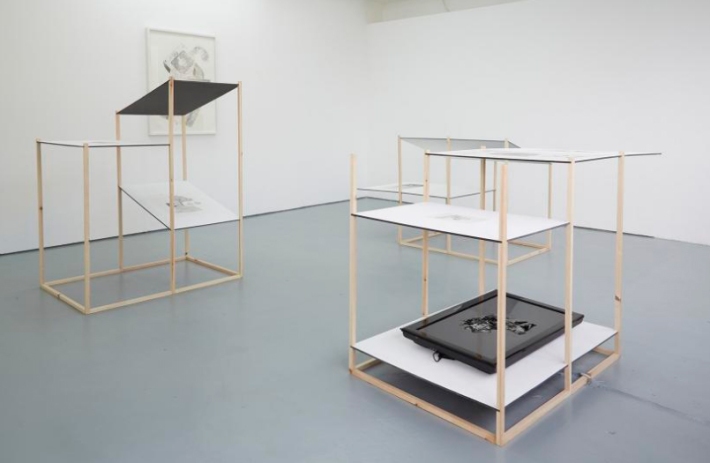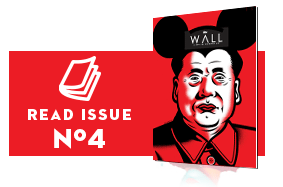
Introducing ‘Metarelics Vol.II’ are amalgams of real, imagined and low res images of objects hand-rendered in pencil on white paper. Installed at varying angles, from horizontal to wall-mounted, the drawings are all static yet revolve around the off-centre, 3D, six-minute animation ‘Schematamorphic Grey Void Test #1 – Netsuke Buddha with Hubble Space Telescope’ (2014). This is the second iteration of Xavier Poultney’s ‘Metarelics’, and it marks a material shift from the presentation of physical objects in ‘Vol.I’, at Tri Outputs in Košice, Slovakia, two years ago.
Quietly commanding the space are three sparse display cases made from wood, which subtly guide the viewer around the works on paper. There are no sides to the structures supporting the drawings in the series ‘Metarelics, Collection #01–09’ (2014) and routes for looking can be charted between and under the unfinished wooden struts. The second drawing in the series is held together with clear references to objects, lines and orientation. It is situated above ‘Schematamorphic Grey Void Test #1 – Netsuke Buddha with Hubble Space Telescope’ (2014), and becomes anchored somehow by the flat screen. The other drawings in the collection situate objects without apparent chronological or compositional hierarchy. Objects drawn from low res image searches degrade into expanses of gradated grey and jump out the other side as geometry. There is a persistent awareness of movement in these fixed drawings, as each one feels more like a single rotation when the viewer has to change position to make an empty grasp at finding the ‘correct’ orientation or definition. This sense recurs in the contrasting high resolution animation, where representations of objects float together to form a rotating mass that moves between the coherent and the illegible.
The second of the two wall-mounted drawings, ‘Superbot Module with Jaw Composite’ (2014), makes clear references to computer hardware, broken up by erasures and a skeletal jaw boxed in by a black rendered square. In fact, a commonality amongst all the drawings is a sense of degradation of detail caused by objects just on the periphery of your vision or by a fading out of detail when your gaze eventually settles. Hito Steyerl’s essay ‘In Defense of the Poor Image’ (2009) comes to mind here, where low res imagery is discussed as immaterial cultural artefact. Steyerl is most preoccupied by the rapid movement, repetition and degradation of digital imagery and there is a suggested relationship here with her ideas and the work in Metarelics Vol.II. In particular, her ideas relate to the inherent uncertainty of Poultney’s hand-rendered objects: drawn from low res image searches, they display the confidence of 18th-century colonial cartography or botanical drawings in some areas, before shifting and dissolving into something completely undefined. Juxtaposed with the movement in the high definition animation, Poultney’s pencil drawings themselves point towards the erasure of the cultural privileging of the high definition and the static artefact itself.
-by Laura Davidson- This is Tomorrow
Location: Space in between
Unit 26 Regent Studios
8 Andrews Rd
London
E8 4QN
Dates: until Sat june 21
Site: www.spaceinbetween.co.uk

